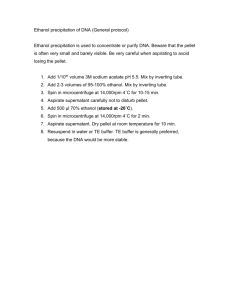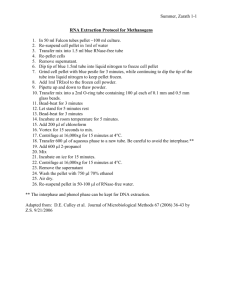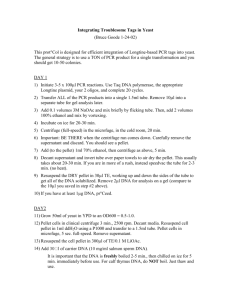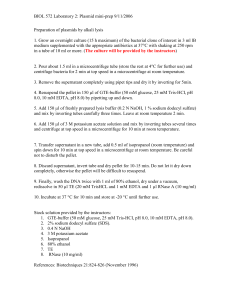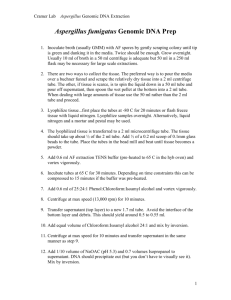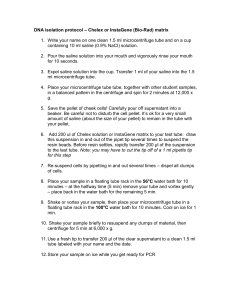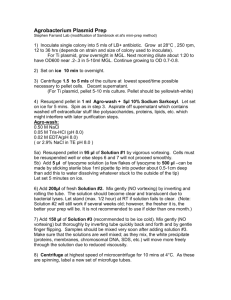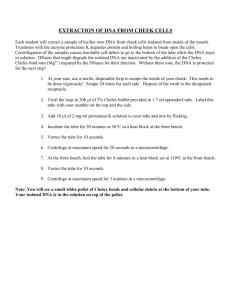DNA Isolation from Drosophila melanogaster (Fly DNA Mini
advertisement
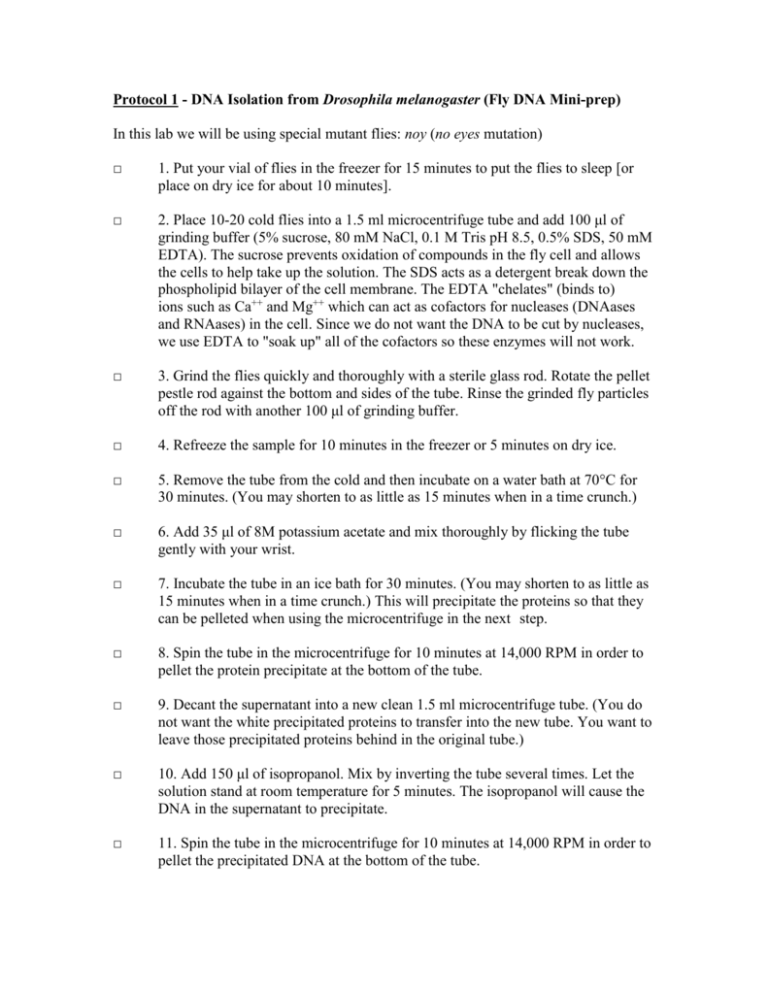
Protocol 1 - DNA Isolation from Drosophila melanogaster (Fly DNA Mini-prep) In this lab we will be using special mutant flies: noy (no eyes mutation) □ 1. Put your vial of flies in the freezer for 15 minutes to put the flies to sleep [or place on dry ice for about 10 minutes]. □ 2. Place 10-20 cold flies into a 1.5 ml microcentrifuge tube and add 100 μl of grinding buffer (5% sucrose, 80 mM NaCl, 0.1 M Tris pH 8.5, 0.5% SDS, 50 mM EDTA). The sucrose prevents oxidation of compounds in the fly cell and allows the cells to help take up the solution. The SDS acts as a detergent break down the phospholipid bilayer of the cell membrane. The EDTA "chelates" (binds to) ions such as Ca++ and Mg++ which can act as cofactors for nucleases (DNAases and RNAases) in the cell. Since we do not want the DNA to be cut by nucleases, we use EDTA to "soak up" all of the cofactors so these enzymes will not work. □ 3. Grind the flies quickly and thoroughly with a sterile glass rod. Rotate the pellet pestle rod against the bottom and sides of the tube. Rinse the grinded fly particles off the rod with another 100 μl of grinding buffer. □ 4. Refreeze the sample for 10 minutes in the freezer or 5 minutes on dry ice. □ 5. Remove the tube from the cold and then incubate on a water bath at 70°C for 30 minutes. (You may shorten to as little as 15 minutes when in a time crunch.) □ 6. Add 35 μl of 8M potassium acetate and mix thoroughly by flicking the tube gently with your wrist. □ 7. Incubate the tube in an ice bath for 30 minutes. (You may shorten to as little as 15 minutes when in a time crunch.) This will precipitate the proteins so that they can be pelleted when using the microcentrifuge in the next step. □ 8. Spin the tube in the microcentrifuge for 10 minutes at 14,000 RPM in order to pellet the protein precipitate at the bottom of the tube. □ 9. Decant the supernatant into a new clean 1.5 ml microcentrifuge tube. (You do not want the white precipitated proteins to transfer into the new tube. You want to leave those precipitated proteins behind in the original tube.) □ 10. Add 150 μl of isopropanol. Mix by inverting the tube several times. Let the solution stand at room temperature for 5 minutes. The isopropanol will cause the DNA in the supernatant to precipitate. □ 11. Spin the tube in the microcentrifuge for 10 minutes at 14,000 RPM in order to pellet the precipitated DNA at the bottom of the tube. □ 12. Pour off the supernatant into a paper towel, leaving the small pellet of DNA at the bottom of the tube. □ 13. Add 100 μl of 70% ethanol to rinse off the DNA pellet and then spin in the microcentrifuge at 14,000 RPM to once again pellet the DNA at the bottom of the tube. □ 14. Pour off the supernatant into a paper towel, leaving the small pellet of DNA at the bottom of the tube. Let the pellet of DNA at the bottom of the tube air-dry by leaving the tube open and inverting it on top of a clean piece of tissue paper. □ 15. After the pellet has dried (about 15 minutes), resuspend the pellet in 100 μl of TE (Tris EDTA) buffer. Be certain to gently flick the tube in order to ensure that the pellet of DNA is dissolved into the TE buffer. □ 16. You may now use this DNA in an experiment or store in the freezer at -20°C.
